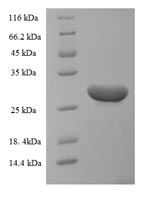The process of expressing the recombinant human BDNF protein in the E.coli requires the recombinant DNA gene formed by the integration of encoding gene for the 129-247aa of the human BDNF protein and N-terminal 6xHis-SUMO tag sequence, the expression vector that the recombinant DNA gene inserts into, the E.coli that provided the necessary macromolecules and components for transcription and translation of the cloned expression vector. After isolation and purification, this N-terminal 6xHis-SUMO-tagged recombinant BDNF protein was obtained. This recombinant BDNF protein is characterized by high purity (>90%, SDS-PAGE). This BDNF protein ran along the gel to the band of approximately 30 kDa molecular weight.
BDNF is a gene providing instruction of making a protein named brain-derived neurotrophic factor (also abbreviated as BDNF) in human and belongs to NGF-beta family. BDNF has a wide array of functions within the brain, involving supporting differentiation, maturation, and survival of neurons in the nervous system. It is highly abundant in the CNS, gut and other tissues. The levels of BDNF are decreased in many neurodegenerative diseases such as Parkinson's disease (PD), multiple sclerosis (MS) and Huntington's disease.






